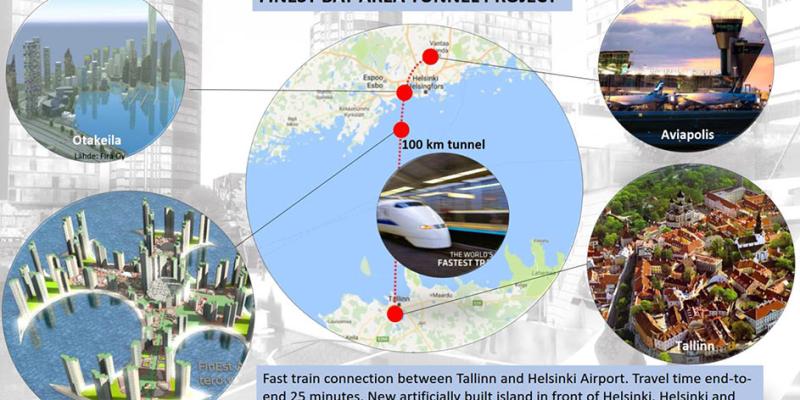Chinese onboard for TBM-bored Helsinki-Tallinn link
Publicerad: 10 september, 2019

Development of a proposed 100km Helsinki-Tallinn rail link has picked up pace in 2019. The environmental impact assessments (EIA) for the project, which will be the longest underground rail route in the world and will be excavated by TBM, are now underway in Finland and Estonia, while engineering companies, ÅF Pöyry and AINS, are progressing design work.
They will now be joined by China Rail International Group (CRIG), which has signed a memorandum of understanding for construction with FinEst Bay Development, the project developer; TouchStone Capital Partners, which is providing funding; and Turkish contractor, GAMA Holding.
The project will include twin 100km rail tunnels for dedicated passenger and freight routes between the airports of Finnish capital, Helsinki, and the Estonian capital, Tallinn, as well as an artificial island off the coast of Finland. High-speed rail services would link the two cities in 20 - 25 minutes, creating a metropolitan zone of more than 2 million people.
EIA runs ahead in Finland, sets slower pace in Estonia
In Finland, the EIA process began more than a year ago and has just completed the public comment phase, Kustaa Valtonen, a cofounder and co-owner of FinEst Bay Area Development, told TunnelTalk in a recent interview. “We are currently going through the feedback and incorporating it into our EIA. We hope to complete the work by late 2019 or early 2020.”
On the Estonian side, the EIA process began in December 2018 and is currently awaiting key decisions by the Estonian Government in order to proceed. “We're working very closely with the government at the moment, responding to requests for further information,” said Valtonen. “Hopefully, when they have received this information, they will make their decisions quickly and we can proceed.”
Completion of the EIA process is the critical next step for the project, as it will determine which route will be developed. Three options are under investigation on the Finnish side of the project, while four will be investigated on the Estonian side. The EIA also provides the foundation for other approvals and permits.
Boring all the way
“In addition to the EIAs, the engineering and technical design has been started by Pöyry and AINS,” said Valtonen. “The work is on a small scale at the moment but will now be accelerated with the addition of CRIG to the team.” The goal is to start construction work at the end of 2020 or early 2021.
Construction of the 100km route will be by TBMs of 17.4m diameter, confirmed Valtonen. “A couple of hundred kilometers is not an easy task, but it is achievable based on the geology between Finland and Estonia. The bedrock is granite and ideal to bore through.” The longest drive will be about 25-30km between two artificial islands that will be created as part of the project. The exact distance will be known on completion of the EIAs, during which the positioning of the islands will be finalised. At its deepest point, the tunnel will drop 250m below sea level.
The project has already begun to look at potential TBM suppliers.”We have been looking at all manufacturers: Herrenknecht, Robbins, and Hitachi, as well as a couple of Chinese alternatives. The decision will be taken in the first half of 2020, when we begin the procurement process.” TBM installation would then begin at some point in 2021 with work expected to last about 2.5 years. This would fit with the ambitious projected opening of the route in late 2024.
The two artificial islands are primarily needed for safety and technical reasons, such as ventilation and emergency exit. They also have environmental benefits as excavated rock will be used to create the islands, reducing the impact along the rest of the route. The larger of the two, which will be off the coast of Finland, will be developed to include commercial and residential spaces.
Project funding
The project budget is set at €15 billion, of which excavation will cost about €12.5 billion. A third of the funding will be provided by TouchStone Capital Partners, which has many Chinese state-owned enterprises as investors. Neither CRIG nor its parent company, China Rail Group (CREC), are investing in the project as part of their involvement, said Vantonen, and Chinese ownership of the project will be limited to less than 50% to allay security fears, particularly on the Estonian side.
Additional investors are now being sought in Europe. “We would like to bring in local Finnish and Nordic funding partners, as well as from Europe, just to keep a good balance of funding”.
If the price tag is substantial, so too are the projected rewards. It is estimated that project investment alone will result in a 1.1%/year increase in Finnish GDP and 2.5%/year increase in Estonian GDP between 2021 and 2025. The long-term economic benefits are expected to be far higher, as the project positions the Helsinki-Tallinn metropolitan region as an important link between Europe and Asia.